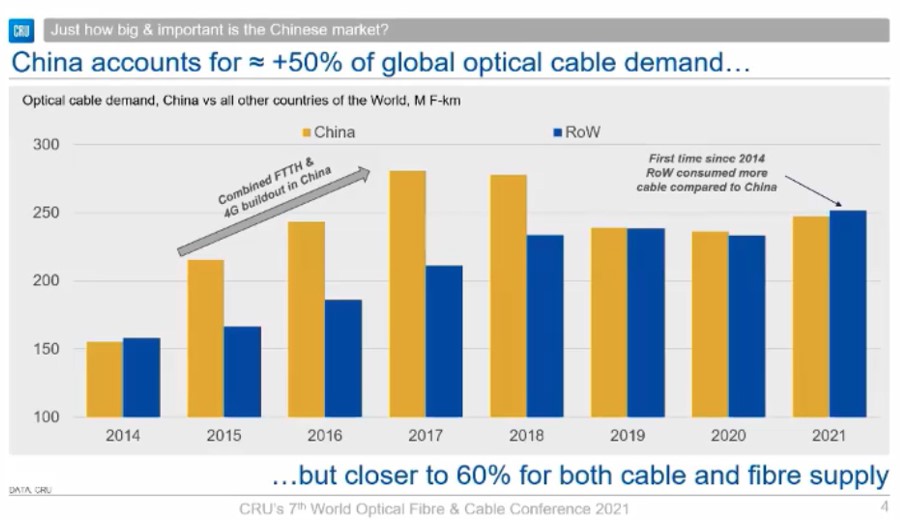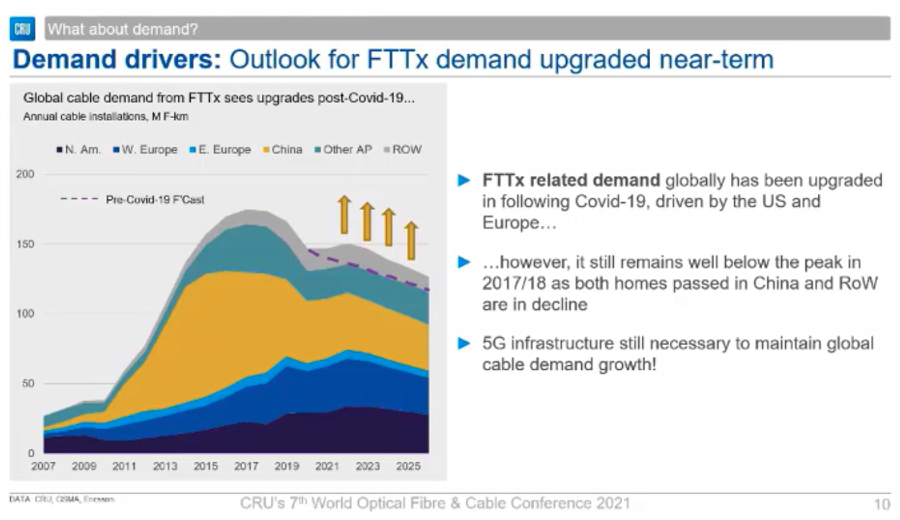C114 News on November 23 (Shuiyi) Recently, the 2021 7th World Optical Fiber & Cable Conference, the top event in the global optical fiber and cable industry, was held in the form of an online conference, attracting people from all over the world. Numerous telecom operators, fiber optic cable manufacturers and upstream and downstream enterprises in the industry chain from all over the world participated in the conference.
Michael Finch, director of cable industry analysis at CRU, a market research firm, delivered a keynote speech, outlining the status and demand of the global optical fiber and cable market, and sharing his insights into how China affects the global market landscape.
Chinese market "determines" global fiber optic cable prices
"How big and how important is the Chinese market?" Michael Finch threw out this "soul torture" at the beginning of his speech. He said that since 2014, China's demand for optical fibers and cables has accounted for about 50% of the world's demand, especially from 2015 to 2018, China has vigorously built FTTH and 4G networks, and the demand ratio is far ahead of other global markets. More importantly, during this period, China's optical fiber and cable supply accounted for nearly 60% of the world's total.

Michael Finch pointed out that in the face of such an important market, the importance of it affecting the global optical fiber and cable market structure cannot be underestimated. According to CRU statistics, from 2013 to 2017 (except 2015), the export of China's optical fiber and cable products to overseas accounted for 4%-6% of the total output, and most of the production capacity was to meet domestic demand. 2018 was a turning point. China's FTTH and 4G construction came to an end, and the supply and demand relationship began to reverse. Manufacturers immediately shifted their focus to exports, and the proportion of exports jumped to 10%.
What does this mean for the global market? Michael Finch said that the most intuitive impact is price. Taking the European market as an example, in 2018, China's demand for optical fibers and cables fell sharply, and European demand did show a rebound, but the price of European optical fibers dropped by nearly 38%. It can be said that, in essence, the price of optical fiber in Europe has been linked to China. "More than ever, the Chinese market determines the price of global fiber optic cables."
In response to this situation, CRU believes that Chinese manufacturers will face more and more market constraints. Not long ago, the European Commission (The European Commission) formally ruled that it will impose anti-dumping duties of 19.7% to 44% on fiber optic cables imported from China. At the same time, Michael Finch said that with the strong mobile demand in China, Chinese manufacturers will pay more attention to domestic demand and reduce exports in 2022, so that the price pressure in Europe, India and Latin America will be released, but they will also bear the burden of Chinese manufacturers. Competitive pressure from joint ventures/subsidiaries established overseas.
Fiber optic cable demand recovery in 2021 exceeds expectations
After talking about the Chinese market, Michael Finch summarized the demand for fiber optic cables in other markets around the world. He pointed out that under the influence of Covid-19, the global demand for FTTx has increased significantly, especially in the United States and Europe, although it is still not comparable to the peak of 2017/18, because of the demand for FTTx in China and other countries and regions are falling. In addition, the construction of 5G infrastructure is still an important part of maintaining the growth of global optical fiber and cable demand.

Throughout Europe, governments, regulators and operators have increased investment and set ambitious FTTH development goals. CRU predicts that Europe will add 25 million FTTH/B home users this year. Benefiting from this, the demand for optical cables in Western Europe in 2021 will increase by 11.3% year-on-year, and the annual growth rate thereafter will remain around 6%. Although the demand in Eastern Europe is not as good as that in Western Europe, it is stable. At the same time, under the support of anti-dumping measures, the price of optical fiber and cable is expected to rise.
The North American market, especially the U.S., will see an upcoming infrastructure bill that will lead to $65 billion in investment in broadband infrastructure, as well as a two-phase $20.4 billion Rural Digital Opportunity Fund (RDOF) for rural and Broadband Internet services are provided in remote areas. According to CRU's forecast, the demand for optical fiber cables in the United States will increase by 11.4% year-on-year in 2021, and there is still more room for growth to 12.7% in 2022.
For the Asia-Pacific region, Michael Finch said, first of all, it is certain that this region will have a profound impact on the global optical cable trade, and there will be more exports. At the same time, the growth of the demand for optical cables in this region is not as high as that in Europe and the United States, but it is very stable.
In emerging market regions, CRU expects fiber optic cable demand to grow at a CAGR of 5%-6% during the period 2022-2026. It is worth mentioning that in terms of broadband networks alone, even by 2026, only 36% of households in emerging markets in Latin America, the Middle East and Africa will use FTTx solutions, and there is huge room for growth.
The growth in demand is accompanied by a series of challenges for the fiber optic cable industry, including rising raw material prices/related input costs; rising energy tariffs and supply constraints; rising freight rates; logistical challenges (transportation issues, delays in port clearance, reduced labor); Fiber optic cable prices have surged in some markets, although fiber optic prices have stabilized…. Michael Finch believes that these challenges will gradually ease and recover in the next 6 months, 12 months and 18 months.
 简体中文
简体中文


